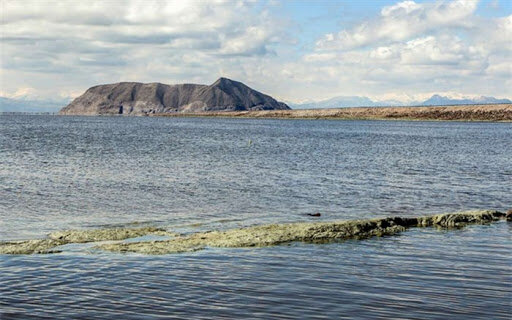Over $1b spent so far to revitalize Lake Urmia

TEHRAN – Since the beginning of the Lake Urmia Restoration Program in October 2013, a total of 4.6 trillion rials (more than $1 billion at the official rate of 42,000 rials) has been spent, Masoud Tajrishi, director of the planning office of the Lake Urmia Restoration Program, has announced.
Shared between West Azarbaijan and East Azarbaijan provinces in northwestern Iran, Lake Urmia, was once the largest salt-water lake in West Asia. It was home to many migratory and indigenous animals including flamingos, pelicans, egrets, and ducks and attracted hundreds of tourists every year who had bathed in the water to take advantage of the therapeutic properties of the lake.
However, decades of long-standing drought spells and elevated hot summer temperatures that speed up evaporation as well as increased water demands in the agriculture sector shrank the lake drastically. In 1999 the volume of water which was at 30 billion cubic meters drastically decreased to half a billion cubic meters in 2013. Moreover, the lake surface area of 5,000 square kilometers in 1997 shrunk to one-tenth of that to 500 square kilometers in 2013.
In total, $5 billion was earmarked for the revitalization of Lake Urmia in the initial plan, of which $1 billion has been spent so far, IRNA quoted Tajrishi as saying on Sunday.
Now the Lake is in a better condition than in previous years, on May 3 this year, lake's water volume was estimated at more than 5 billion cubic meters, while last year at this time it was about 4 billion cubic meters, he highlighted.
Since the current water year (September 23, 2019), the amount of rainfall in the water basin of Lake Urmia has been 30 percent less than in the previous water year and 7 percent less than the whole country, he stated.
He went on to explain that over the past 51 years, precipitation has increased by 13 percent in this basin and by 35 percent in the whole country, while with 30 percent less rainfall than last year, the lake is almost in a better condition.
Considering the predicted hot summer this year, he said that It is predicted that evaporation will definitely increase.
This year, with 320 mm rise in rainfall in the catchment area of Lake Urmia, the lake's level experienced a 13 cm raise, the other indicator of which is the improvement of the situation of Kaboudan, Arezoo, Spir and Ashk islands, he noted.
He also added that Kaboudan and Arezoo islands are connected when water overflows, almost over a thousand urials have been counted in the islands, in addition to more than 64,000 flamingos.
Referring to 6 years of restoration program, he said that the lake’s condition is currently being stabilized, the revitalization of the lake is divided into three phases: stabilization, revitalization, and final revitalization.
However, once we can claim that the lake is revived when there is no more sand and dust resources and that the quality of water, ecology, and recreation in this basin is in the best condition, he highlighted.
The water right of the lake is 3.3 billion cubic meters annually, he further emphasized.
In previous years, not providing the water right of the lake was considered as the most important cause of its gradual drying up; in the past, the main rivers in the catchment area were not dredged and due to sedimentation, but over the past 6 years, 253 kilometers of lake beds were dredged, Tajrishi explained.
He went on to point out that excessive farming and cultivation of water consuming crops in the surrounding areas are other causes of its drying up so that the Restoration Program tried to reduce water consumption by 40 percent in agriculture.
Therefore, modern irrigation and modification of cultivation patterns are on the agenda, he said, pointing out that in the past, water-consuming crops such as beets and corn were abundantly cultivated in its catchment area, but we improved and replaced medicinal plants such as saffron to minimize the use of water, he explained.
Under the biological stabilization project of dust centers in the catchment area of Lake Urmia, some 23,000 hectares have undergone seedling and vegetation planting, and also in one million hectares were smoothed, which had a favorable effect on plant growth and dust control, he also explained.
This is while Lake Urmia still needs 9.5 billion cubic meters of water to reach its ecological level of 1274.10.
These days, life has returned to Lake Urmia. The lake now has so much water that tourists can swim in its shiny water and birds and aquatic species such as flamingos and Artemia have returned to it, but we should not forget the hard days it went through. Lake Urmia still has a long way to completely survive, and neglect can threaten this precious gem of Iran again.
FB/MG
